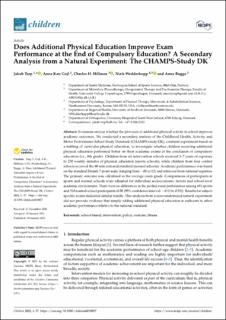| dc.contributor.author | Tarp, Jakob | |
| dc.contributor.author | Gejl, Anne Kær | |
| dc.contributor.author | Hillman, Charles H. | |
| dc.contributor.author | Wedderkopp, Niels | |
| dc.contributor.author | Bugge, Anna | |
| dc.date.accessioned | 2021-12-08T15:21:39Z | |
| dc.date.available | 2021-12-08T15:21:39Z | |
| dc.date.created | 2021-09-13T12:35:51Z | |
| dc.date.issued | 2021 | |
| dc.identifier.citation | Children. 2021, 8(1), Artikkel 57. | en_US |
| dc.identifier.issn | 2227-9067 | |
| dc.identifier.uri | https://hdl.handle.net/11250/2833446 | |
| dc.description | This article is an open access article distributed under the terms and conditions of the Creative Commons Attribution (CC BY) license (https://creativecommons.org/licenses/by/4.0/). | en_US |
| dc.description.abstract | It remains unclear whether the provision of additional physical activity in school improves academic outcomes. We conducted a secondary analysis of the Childhood Health, Activity, and Motor Performance School Study Denmark (CHAMPS-study DK), a natural experiment based on a trebling of curricular physical education, to investigate whether children receiving additional physical education performed better on their academic exams at the conclusion of compulsory education (i.e., 9th grade). Children from six intervention schools received 3–7 years of exposure to 270 weekly minutes of physical education (sports schools), while children from four control schools received the 90-min national standard (normal schools). Academic performance was based on the standard Danish 7-point scale (ranging from −03 to 12) and retrieved from national registries. The primary outcome was calculated as the average exam grade. Comparisons of participants at sports and normal schools were adjusted for individual socioeconomic factors and school-level academic environment. There were no differences in the pooled exam performance among 691 sports- and 510 normal-school participants (0.20 (95% confidence interval: −0.12 to 0.52)). Results for subject-specific exams indicated similar results. This analysis from a non-randomized natural experiment did not provide evidence that simply adding additional physical education is sufficient to affect academic performance relative to the national standard. | en_US |
| dc.language.iso | eng | en_US |
| dc.subject | exercise | en_US |
| dc.subject | fitness | en_US |
| dc.subject | intervention | en_US |
| dc.subject | policy | en_US |
| dc.subject | school-based | en_US |
| dc.title | Does additional physical education improve exam performance at the end of compulsory education?: A secondary analysis from a natural experiment: The CHAMPS-study DK | en_US |
| dc.type | Peer reviewed | en_US |
| dc.type | Journal article | en_US |
| dc.description.version | publishedVersion | en_US |
| dc.rights.holder | © 2021 by the authors | en_US |
| dc.source.pagenumber | 11 | en_US |
| dc.source.volume | 8 | en_US |
| dc.source.journal | Children | en_US |
| dc.source.issue | 1 | en_US |
| dc.identifier.doi | 10.3390/children8010057 | |
| dc.identifier.cristin | 1933720 | |
| dc.description.localcode | Institutt for idrettsmedisinske fag / Department of Sports Medicine | en_US |
| dc.source.articlenumber | 57 | en_US |
| cristin.ispublished | true | |
| cristin.fulltext | original | |
| cristin.qualitycode | 1 | |
